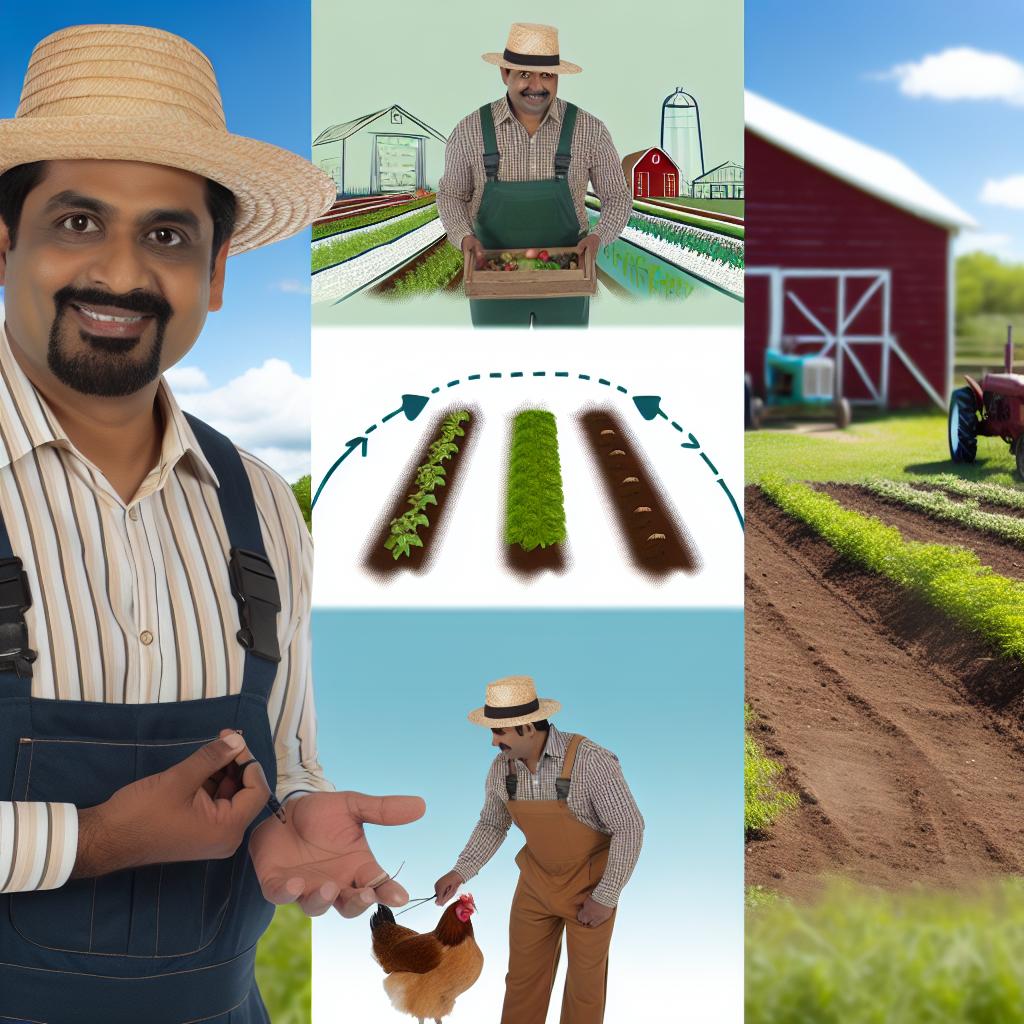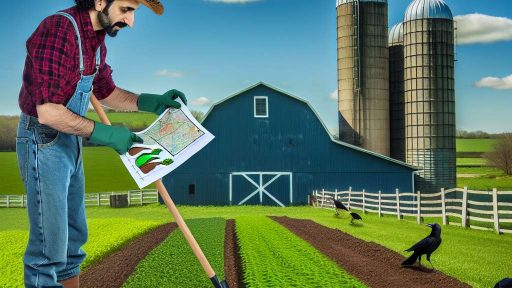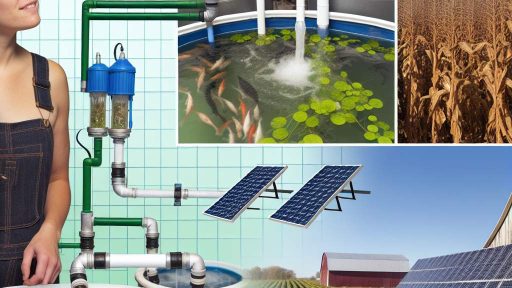Introduction to Permaculture Principles
Permaculture offers a holistic approach to farming and gardening.
It integrates land, resources, and people into sustainable systems.
This framework emphasizes working with nature rather than against it.
Understanding these principles can enhance farm diversification.
Core Values of Permaculture
Care for the Earth is a fundamental value.
This principle prioritizes sustainable practices that protect ecosystems.
Next, care for people ensures a supportive community.
This value promotes sharing resources and knowledge.
Finally, fair share encourages equitable distribution of surplus.
These values guide decision-making in permaculture farming.
Key Principles of Permaculture Design
Observe and interact is the first principle.
Farmers should take the time to observe their environment.
Next, catch and store energy supports efficient resource use.
Implementing solar energy systems exemplifies this principle.
Furthermore, obtain a yield highlights the need for productivity.
Transform Your Agribusiness
Unlock your farm's potential with expert advice tailored to your needs. Get actionable steps that drive real results.
Get StartedFarmers should design systems that provide food or income.
Implementing Permaculture Practices
Companion planting is a widely used permaculture strategy.
This method enhances plant growth and pest control.
Another approach involves creating swales to manage water.
This practice improves soil moisture retention and reduces erosion.
Moreover, incorporating diverse crops leads to healthier ecosystems.
These strategies collectively support effective farm diversification.
Understanding the Concept of Farm Diversification
Defining Farm Diversification
Farm diversification involves integrating various agricultural enterprises.
It enhances the resilience of farming operations.
Moreover, it spreads risk across multiple products and markets.
Farmers can increase profitability by diversifying their offerings.
Reasons for Diversification
Diverse farming operations respond better to market fluctuations.
They provide a buffer against crop failures or price drops.
Additionally, diversification can improve soil health and ecosystem balance.
It allows farmers to take advantage of different growing seasons.
Also, it can attract a wider customer base and new revenue streams.
Types of Farm Diversification
Farm diversification can take many forms.
- Crop diversification includes planting various crops.
- Livestock diversification incorporates different animal species.
- Value-added products enhance farm income through processing.
- Agritourism offers visitors farm experiences and educational opportunities.
Research and Planning
Effective diversification starts with thorough research.
Farmers should analyze market trends and consumer preferences.
Additionally, they need to assess available resources and skills.
Creating a comprehensive business plan helps outline strategies.
Implementing Diversification Strategies
Farmers can begin by introducing a new crop or livestock type.
They can also explore partnerships with local businesses.
Experimenting with seasonal diversification can yield great benefits.
Showcase Your Farming Business
Publish your professional farming services profile on our blog for a one-time fee of $200 and reach a dedicated audience of farmers and agribusiness owners.
Publish Your ProfileFinally, embracing technology will enhance efficiencies and productivity.
The Importance of Biodiversity in Permaculture
Enhancing Ecosystem Resilience
Biodiversity enhances ecosystem resilience significantly.
Healthy ecosystems can better withstand environmental changes.
For example, a diverse farm can resist pests more effectively.
This reduces reliance on chemical pesticides and fertilizers.
Optimizing Resource Use
Diverse plant and animal species optimize resource use.
Different species utilize soil, water, and sunlight variably.
This efficient resource use maximizes productivity across the farm.
As a result, permaculture systems become more sustainable.
Supporting Soil Health
Biodiversity plays a crucial role in maintaining soil health.
Various root structures improve soil aeration and structure.
Additionally, different plants contribute organic matter to the soil.
This organic matter enhances soil fertility and moisture retention.
Promoting Pollinator Habitats
Diverse plants provide essential habitats for pollinators.
Pollinators like bees and butterflies boost crop yields significantly.
By planting a variety of flowers, farmers can attract these beneficial insects.
This increases the overall productivity of the farm.
Encouraging Natural Pest Control
Biodiversity encourages natural pest control mechanisms.
Diverse habitats attract a variety of predatory species.
These predators can effectively manage pest populations.
This creates a balanced ecosystem, reducing the need for pesticides.
Enhancing Flavor and Nutrition
Diverse crops can enhance the flavor and nutritional value of food.
Different species offer various vitamins, minerals, and antioxidants.
This diversity results in healthier and more flavorful produce.
Consequently, consumers enjoy a better diet from diverse farms.
You Might Also Like: Organic Farming as a Diversification Approach
Principle of Designing for Stability and Resilience
Importance of Stability
Stability creates a foundation for sustainable farming.
Farm stability reduces risks associated with unpredictable environmental changes.
Furthermore, it enhances productivity over the long term.
Understanding Resilience
Resilience enables farms to adapt to challenges.
Resilient systems recover quickly from setbacks.
They can withstand pests, diseases, and climate fluctuations.
Integrating Diversity
Diversifying crops and livestock promotes stability.
This strategy minimizes dependence on a single resource.
Moreover, it balances risks across multiple species.
Enhancing Soil Health
Healthy soil is crucial for stable farming systems.
Practices like crop rotation improve soil fertility.
Incorporating cover crops adds organic matter and nutrients.
Water Management Strategies
Effective water management supports resilient farming.
Implementing rainwater harvesting systems conserves water.
Showcase Your Farming Business
Publish your professional farming services profile on our blog for a one-time fee of $200 and reach a dedicated audience of farmers and agribusiness owners.
Publish Your ProfileAdditionally, using swales directs water efficiently across fields.
Community Engagement
Building community networks strengthens farm resilience.
Farmers can share resources and information effectively.
Collaborative practices often lead to innovative solutions.
Monitoring and Adaptation
Consistent monitoring identifies potential issues early.
Farmers should adapt practices based on observed results.
This iterative process fosters ongoing improvements.
Discover More: Smart Farming Solutions Enhancing Agricultural Efficiency
Utilizing Zones and Sectors in Farm Layout
Defining Zones
Zones are essential elements in permaculture design.
They categorize areas based on their level of use and disturbance.
Zone one requires the most attention and inputs.
This zone typically houses kitchen gardens and high-maintenance plants.
As you move outward, zones become less intensive in cultivation.
Zone two includes food crops that require regular harvesting.
Zone three hosts less frequently visited areas like orchards and shrubs.
Zones four and five focus on wild, nature-managed ecosystems.
Utilizing Sectors
Sectors are directional forces affecting the farm environment.
They include elements such as wind, sun, and water flow.
Understanding these sectors is vital for optimal layout design.
For instance, heavy winds can damage crops and buildings.
To mitigate this, trees can serve as windbreaks.
Sun angles dictate where to plant sun-loving versus shade-preferring crops.
Likewise, water flows inform irrigation and drainage planning.
Integrating Zones and Sectors
The integration of zones and sectors enhances farm efficiency.
For example, place greenhouses in zone one, away from harsh winds.
Utilize natural barriers in sectors to protect sensitive plants.
Incorporate gardens that thrive in sun-facing zones.
Each zone should be positioned considering surrounding sectors.
This approach maximizes resource use and minimizes maintenance.
Benefits of Strategic Layout
A well-planned layout reduces waste and improves productivity.
It allows for a diverse array of crops while maintaining ecological balance.
Moreover, understanding zones and sectors fosters sustainable practices.
Farmers can achieve greater resilience against climate shifts.
This strategic diversification ultimately leads to long-term benefits.
Delve into the Subject: Automating Farm Operations With Cutting Edge Tools
Integrating Livestock for Soil Health and Pest Management
Enhancing Soil Fertility
Livestock plays a vital role in enhancing soil fertility.
Manure from animals enriches the soil with nutrients.
This practice boosts organic matter content significantly.
Furthermore, it promotes healthy microbial activity in the soil.
Pest Management Strategies
Integrating livestock can help control pests naturally.
Showcase Your Farming Business
Publish your professional farming services profile on our blog for a one-time fee of $200 and reach a dedicated audience of farmers and agribusiness owners.
Publish Your ProfileChickens, for instance, effectively manage insect populations.
Their foraging behavior reduces pests without chemical interventions.
Similarly, ducks can target slugs and snails in gardens.
Maintaining Biodiversity
Including livestock in farming enhances biodiversity on the farm.
This diversity helps create a more resilient ecosystem.
Different animal species contribute to a balanced food web.
Additionally, varied livestock can support diverse plant systems.
Improving Pasture Health
Well-managed grazing can rejuvenate pastures over time.
Rotational grazing techniques prevent overgrazing and soil compaction.
These practices lead to richer, more productive soil.
Healthy pastures can sequester more carbon underground.
Contributing to a Circular Economy
Integrating livestock promotes a circular approach in farming.
Waste from one species serves as a resource for another.
This interconnectedness reduces reliance on external inputs.
Hence, it fosters a more sustainable farming system.
Discover More: Understanding Farm Insurance To Ensure Financial Stability

Water Management Strategies in Diverse Farming Systems
Importance of Water Management
Water management plays a crucial role in farming sustainability.
Effective strategies enhance crop yields and conserve resources.
Furthermore, proper management curbs soil erosion and nutrient loss.
Understanding Water Needs
Every crop has unique water requirements.
Understanding these needs improves irrigation efficiency.
Additionally, consider the local climate and seasonal patterns.
Implementing Rainwater Harvesting
Rainwater harvesting captures and stores runoff.
This method reduces dependence on groundwater sources.
Moreover, it provides a sustainable water supply during dry spells.
Choosing Appropriate Irrigation Systems
Selecting the right irrigation system maximizes water usage.
Drip irrigation delivers water directly to plant roots.
This technique minimizes evaporation and runoff losses.
Conversely, overhead sprinklers can effectively cover larger areas.
Utilizing Soil Moisture Sensors
Soil moisture sensors monitor moisture level in real-time.
These tools help optimize watering schedules.
Consequently, they prevent over-irrigation and conserve water.
Incorporating Mulching Techniques
Mulching retains soil moisture and suppresses weeds.
This practice reduces the need for frequent watering.
Additionally, organic mulches can improve soil health over time.
Designing Water-Conserving Landscapes
Landscape design impacts water management efficiency.
Implementing contour farming captures rainfall effectively.
Similarly, swales and buffer strips enhance water infiltration.
Adopting Agroecology Principles
Agroecology emphasizes using natural processes to manage water.
This approach improves biodiversity and resilience in farming systems.
Showcase Your Farming Business
Publish your professional farming services profile on our blog for a one-time fee of $200 and reach a dedicated audience of farmers and agribusiness owners.
Publish Your ProfileIt fosters interactions between crops, livestock, and water cycles.
Community Engagement and Knowledge Sharing
Engaging with local farmers promotes sharing water management techniques.
Community workshops can educate on best practices.
Moreover, collaboration fosters innovation and problem-solving.
Creating Microclimates to Enhance Crop Variety
Understanding Microclimates
Microclimates refer to localized climate variations within a larger area.
These variations can occur due to topography, vegetation, or structures.
Farmers can leverage these differences to promote diverse crop growth.
Benefits of Microclimates
Microclimates can create unique conditions for various plants.
They help extend growing seasons for sensitive crops.
Furthermore, they can protect plants from harsh weather elements.
Creating Microclimates on Your Farm
A variety of techniques can help create beneficial microclimates.
- Planting windbreaks can reduce wind exposure.
- Using shade cloths can provide relief from intense sun.
- Incorporating water features can increase humidity and local temperatures.
Choosing Suitable Crops
Select crops that thrive in your specific microclimate.
For instance, cooler areas might support leafy greens better.
Warmer spots could be ideal for heat-loving vegetables.
Monitoring and Adjusting Practices
Regular monitoring of microclimate conditions is essential.
Track temperature, moisture, and sunlight exposure.
Adjust planting and care practices based on observed conditions.
Case Study: Green Oak Farm
Green Oak Farm successfully utilizes microclimates for crop diversity.
They employ windbreaks made of native trees.
These trees not only protect crops but also enhance biodiversity.
Maximizing Benefits Through Multi-Layering
Implementing multi-layered planting strategies maximizes microclimate benefits.
Combining tall plants with ground cover increases diversity.
This approach results in healthier ecosystems and improved yields.
The Role of Agroforestry in Sustainable Diversification
Understanding Agroforestry
Agroforestry combines agriculture and forestry practices.
This integration enhances biodiversity and productivity.
Farmers cultivate crops alongside trees and shrubs.
Roots stabilize soil and reduce erosion.
Furthermore, trees provide shade for crops.
This shade can lead to improved plant growth.
Benefits of Agroforestry
Agroforestry offers several significant benefits.
- It increases farm resiliency against climate change.
- This method diversifies income sources for farmers.
- Agroforestry improves soil health and fertility.
- This practice enhances wildlife habitat on farms.
Ecological Advantages
One ecological advantage is enhanced biodiversity.
Diverse plant species contribute to better pest management.
Additionally, increased biodiversity promotes pollination.
In turn, this can lead to higher crop yields.
Implementing Agroforestry on Farms
Farmers should assess their land and resources.
Identifying native tree species is crucial.
Next, they must determine suitable crop combinations.
Create a plan that aligns with local climate conditions.
Finally, consider a phased approach to implementation.
Challenges and Solutions
Adopting agroforestry can present challenges.
Showcase Your Farming Business
Publish your professional farming services profile on our blog for a one-time fee of $200 and reach a dedicated audience of farmers and agribusiness owners.
Publish Your ProfileHowever, education and planning can mitigate these issues.
Farmers can seek support from local agricultural organizations.
Additionally, accessing financial assistance is vital.
Case Studies
Successful agroforestry projects span the globe.
In Brazil, farmers combine cocoa with shade trees.
This method improves yields and benefits the environment.
In India, mango trees intercropped with legumes enhance biodiversity.
These examples showcase the versatility of agroforestry.
Additional Resources
Combat Food Waste with Sustainable Agriculture & Farming | Shapiro
Evaluating the Effectiveness of Locally Available Woodchips for …




